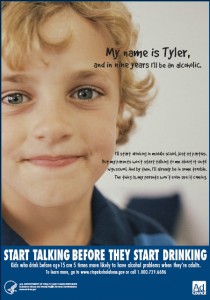19
Mental Monday: Just How Badly Do You Need That Drink?
As I mentioned in a blog post a few weeks ago, April is Alcohol Awareness Month.
That blog post was about the importance of talking to your children about alcohol and I link to a great website developed by the U.S. Department of Health and Human Services. Now I want to take this discussion even further and dispense a little more information about alcohol abuse, alcohol dependence, and alcohol facts, in general. Why? Because there are millions of people affected by alcohol everyday, whether it’s due to their own alcohol problem or because someone they love has a problem. The U.S. has one of the highest rates of alcohol abuse and dependence in the world and most people know at least one person who has a problem with alcohol. People with alcohol problems need help. It is not something that can be cured on its own without treatment and support. It is something that needs to be recognized and addressed. Treatment for alcohol abuse and dependence is imperative, not only for the health of the person with the problem but for everyone else in their life as well.
What is Alcoholism?
I don’t use the term *alcoholic.* The term *alcoholic* is not a medical or legal term. Instead, I use the terms *alcohol abuse* and *alcohol dependence*. Both can easily be lumped into the term *alcoholic,* but there is a difference:
Alcohol Abuse is the compulsive use of alcohol, using alcohol in excess and during substantial periods of time, planning and thinking about it often, and continuing to use it despite problems. Abusing alcohol impacts relationships and will often impair the ability to function day-to-day.
Alcohol Dependence is a physiological dependence where symptoms for withdrawal will occur after 12 hours of stopping use. Withdrawal symptoms include trembling, sweating, heart palpitations, vomiting, nausea, seizures, delirium, and possible death. Unlike withdrawal from narcotics, withdrawal from alcohol can result in death without in-patient care. You read that correctly: It is the only substance where there is a risk of death during the withdrawal process. Another important piece of information to note is that adolescents do not experience alcohol withdrawal, which is most likely due to the difference in their liver function.
Just because someone abuses alcohol does not mean they are necessarily dependent on alcohol. At least, not yet. Only someone who craves alcohol, needs a large quantity of alcohol to get *high*, cannot stop drinking, and experiences withdrawal symptoms can be defined as alcohol dependent. However, both categories of drinkers will require assistance to quit. (continues…)
02
Start Talking Before They Start Drinking
 Did you know that the month of April has been designated Alcohol Awareness Month? I didn’t either until I was contacted on behalf of the new Underage Drinking website, which was developed by the U.S. Department of Health and Human Services. This new public education website was created in support of the Surgeon General’s call to action to bring more awareness to parents about the negative effects of drinking alcohol at an early age. Alcohol abuse is a critical issue because it remains the biggest substance abuse problem among our youth.
Did you know that the month of April has been designated Alcohol Awareness Month? I didn’t either until I was contacted on behalf of the new Underage Drinking website, which was developed by the U.S. Department of Health and Human Services. This new public education website was created in support of the Surgeon General’s call to action to bring more awareness to parents about the negative effects of drinking alcohol at an early age. Alcohol abuse is a critical issue because it remains the biggest substance abuse problem among our youth.
Some startling facts about underage drinking:
- Children who first use alcohol before the age of 15 are six times more likely to have alcohol problems than those who start drinking after the age of 21.
- 40% of children have tried alcohol before 8th grade.
- 75% of high school seniors have tried alcohol.
- According to the National Institute on Alcohol Abuse and Alcoholism, approximately 5,000 people under the age of 21 die as a result of drinking alcohol.
- 11% of 8th graders, 22% of 10th graders, and 29% of 12th graders have engaged in heavy episodic (binge) drinking.
- Children are starting to drink much earlier than ever before. The average age of first use in 2003 was 14. In 1965, the average age was 17.5.
The new website suggests short and frequent discussions rather than have “the talk” which can be long and intimidating for children. Many children will simply tune parents out, especially if they are being talked *at* and not *to.* When you start a dialogue with your child, make sure to ask them questions and make time for their questions, too. Another important factor is to establish your rules and thoughts on alcohol use early and consistently. (continues…)

